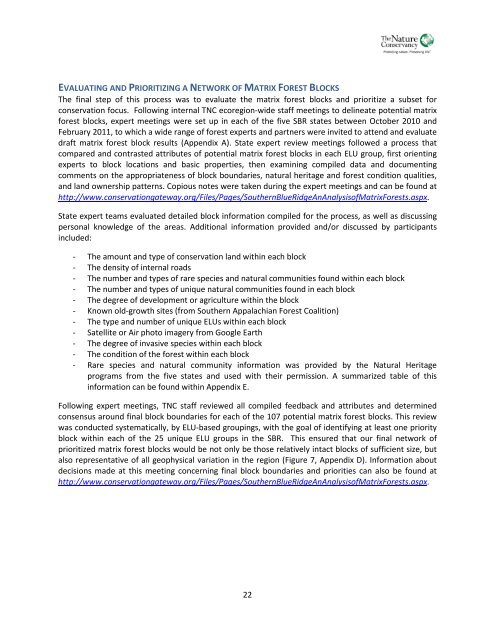Southern Blue Ridge: An Analysis of Matrix Forests - Conservation ...
Southern Blue Ridge: An Analysis of Matrix Forests - Conservation ...
Southern Blue Ridge: An Analysis of Matrix Forests - Conservation ...
Create successful ePaper yourself
Turn your PDF publications into a flip-book with our unique Google optimized e-Paper software.
EVALUATING AND PRIORITIZING A NETWORK OF MATRIX FOREST BLOCKSThe final step <strong>of</strong> this process was to evaluate the matrix forest blocks and prioritize a subset forconservation focus. Following internal TNC ecoregion-wide staff meetings to delineate potential matrixforest blocks, expert meetings were set up in each <strong>of</strong> the five SBR states between October 2010 andFebruary 2011, to which a wide range <strong>of</strong> forest experts and partners were invited to attend and evaluatedraft matrix forest block results (Appendix A). State expert review meetings followed a process thatcompared and contrasted attributes <strong>of</strong> potential matrix forest blocks in each ELU group, first orientingexperts to block locations and basic properties, then examining compiled data and documentingcomments on the appropriateness <strong>of</strong> block boundaries, natural heritage and forest condition qualities,and land ownership patterns. Copious notes were taken during the expert meetings and can be found athttp://www.conservationgateway.org/Files/Pages/<strong>Southern</strong><strong>Blue</strong><strong>Ridge</strong><strong>An</strong><strong>An</strong>alysis<strong>of</strong><strong>Matrix</strong><strong>Forests</strong>.aspx.State expert teams evaluated detailed block information compiled for the process, as well as discussingpersonal knowledge <strong>of</strong> the areas. Additional information provided and/or discussed by participantsincluded:- The amount and type <strong>of</strong> conservation land within each block- The density <strong>of</strong> internal roads- The number and types <strong>of</strong> rare species and natural communities found within each block- The number and types <strong>of</strong> unique natural communities found in each block- The degree <strong>of</strong> development or agriculture within the block- Known old-growth sites (from <strong>Southern</strong> Appalachian Forest Coalition)- The type and number <strong>of</strong> unique ELUs within each block- Satellite or Air photo imagery from Google Earth- The degree <strong>of</strong> invasive species within each block- The condition <strong>of</strong> the forest within each block- Rare species and natural community information was provided by the Natural Heritageprograms from the five states and used with their permission. A summarized table <strong>of</strong> thisinformation can be found within Appendix E.Following expert meetings, TNC staff reviewed all compiled feedback and attributes and determinedconsensus around final block boundaries for each <strong>of</strong> the 107 potential matrix forest blocks. This reviewwas conducted systematically, by ELU-based groupings, with the goal <strong>of</strong> identifying at least one priorityblock within each <strong>of</strong> the 25 unique ELU groups in the SBR. This ensured that our final network <strong>of</strong>prioritized matrix forest blocks would be not only be those relatively intact blocks <strong>of</strong> sufficient size, butalso representative <strong>of</strong> all geophysical variation in the region (Figure 7, Appendix D). Information aboutdecisions made at this meeting concerning final block boundaries and priorities can also be found athttp://www.conservationgateway.org/Files/Pages/<strong>Southern</strong><strong>Blue</strong><strong>Ridge</strong><strong>An</strong><strong>An</strong>alysis<strong>of</strong><strong>Matrix</strong><strong>Forests</strong>.aspx.22
















